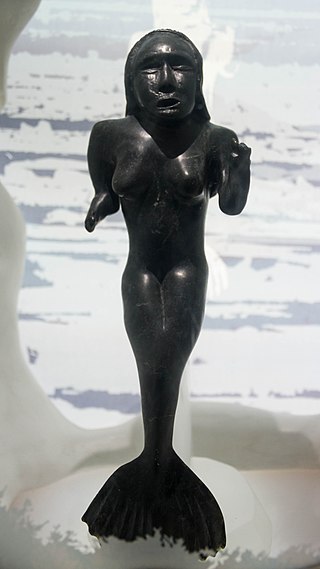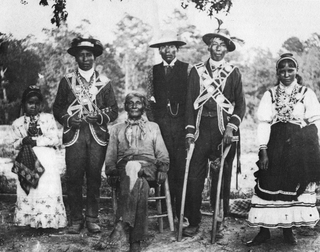Related Research Articles
Maya or Mayan mythology is part of Mesoamerican mythology and comprises all of the Maya tales in which personified forces of nature, deities, and the heroes interacting with these play the main roles. The myths of the era have to be reconstructed from iconography. Other parts of Mayan oral tradition are not considered here.

Inuit religion is the shared spiritual beliefs and practices of the Inuit, an indigenous people from Alaska, northern Canada, parts of Siberia and Greenland. Their religion shares many similarities with some Alaska Native religions. Traditional Inuit religious practices include animism and shamanism, in which spiritual healers mediate with spirits. Today many Inuit follow Christianity, but traditional Inuit spirituality continues as part of a living, oral tradition and part of contemporary Inuit society. Inuit who balance indigenous and Christian theology practice religious syncretism.

Choctaw mythology is part of the culture of the Choctaw, a Native American tribe originally occupying a large territory in the present-day Southeastern United States: much of the states of Mississippi, Alabama, and Louisiana. In the 19th century, the Choctaw were known to European Americans as one of the "Five Civilized Tribes" even though controversy surrounds their removal.

Mythology of the Iroquois includes the creation stories and folktales of the Native Americans who formed the confederacy of the Five Nations, later the Six Nations. Historically, these stories were recorded in wampum and recited, only being written down later. In the written versions, the spellings of names differ due to transliteration and spelling variations in European languages that were not yet standardized. Variants of the stories exist, reflecting different localities and times.
The Abenaki people are an indigenous peoples of the Americas located in the Northeastern Woodlands region. Their religious beliefs are part of the Midewiwin tradition, with ceremonies led by medicine keepers, called Medeoulin or Mdawinno.
In Gamilaraay mythology), Yhi is a female creator spirit and personification of the sun. She chases Bahloo across the sky; supernovas are said to happen when she catches up to him.

Philippine mythology is the body of stories and epics originating from, and part of, the indigenous Philippine folk religions, which include various ethnic faiths distinct from one another. Philippine mythology is incorporated from various sources, having similarities with Indonesian and Malay myths, as well as Hindu, Muslim, Shinto, Buddhist, and Christian traditions, such as the notion of heaven, hell, and the human soul. Philippine mythology attempts to explain the nature of the world through the lives and actions of heroes, deities, and mythological creatures. The majority of these myths were passed on through oral tradition, and preserved through the aid of community spiritual leaders or shamans and community elders.
The Gamilaraay, also known as Gomeroi, Kamilaroi, Kamillaroi and other variations, are an Aboriginal Australian people whose lands extend from New South Wales to southern Queensland. They form one of the four largest Indigenous nations in Australia.
In Australian Aboriginal mythology of the Bundjalung, an area known as "the land of the three rivers, "the Dirawong, an unseen spiritual creature also known as the goanna spirit, is one of the Creator Beings of the Bundjalung, that 1) Protects 2) Guards, 3) Battles the Rainbow Snake, 4) Helps the people with,

Melanesian mythology refers to the folklore, myths, and religions of Melanesia, a region in Southwest Oceania that encompasses the archipelagos of New Guinea, the Torres Strait Islands, Solomon Islands, Vanuatu, New Caledonia and Fiji.
The mythology of the modern-day Netherlands, Belgium and Luxembourg has its roots in the mythologies of pre-Christian cultures, predating the region's Christianization under the influence of the Franks in the Early Middle Ages. At the time of the Roman Empire and in the Early Middle Ages, some of the resident peoples of the Low Countries' included:
There are a vast array of myths surrounding the Blackfoot Native Americans as well as Aboriginal people. The Blackfeet inhabit the Great Plains, in the areas known as Alberta, Saskatchewan, and areas of Montana. These stories, myths, origins, and legends play a big role in their everyday life, such as their religion, their history, and their beliefs. Only the elders of the Blackfoot tribes are allowed to tell the tales, and are typically difficult to obtain because the elders of the tribes are often reluctant to tell them to strangers who are not of the tribe. People such as George B. Grinnell, John Maclean, D.C. Duvall, Clark Wissler, and James Willard Schultz were able to obtain and record a number of the stories that are told by the tribes.

West African mythology is the body of myths of the people of West Africa. It consists of tales of various deities, beings, legendary creatures, heroes and folktales from various ethnic groups. Some of these myths traveled across the Atlantic during the period of the Trans-Atlantic slave trade to become part of Caribbean, Cuban and Brazilian mythology.

In Australian Aboriginal religion and mythology, Crow is a trickster, culture hero and ancestral being. In the Kulin nation in central Victoria he is known as Waang and is regarded as one of two moiety ancestors, the other being the more sombre eaglehawk Bunjil. Legends relating to Crow have been observed in various Aboriginal language groups and cultures across Australia.
Tsunki is the name for the primordial spirit shaman within the Shuar people and the Achuar people of Amazonia. The term is derived from the Jivaroan language family. The term Tsunki can also be translated as meaning the first shaman and is frequently alluded to in shamanic songs.
The Yuwaalaraay, also spelt Euahlayi, Euayelai, Eualeyai, Ualarai, Yuwaaliyaay and Yuwallarai, are an Aboriginal Australian people of north-western New South Wales.
Mungoon-Gali, also transcribed as Mungoongarlee, is a giant goanna from Yuwaalaraay mythology who terrorised the local people with his venomous bite and voracious appetite. Afraid the tribes would soon be wiped out by the constant attacks, Ouyouboolooey the black snake offered to steal the hidden poison bag from Mungoon-Gali for in those days, it was lizards instead of snakes that were venomous. He waited until the goanna was resting after a large meal before offering to reveal the tribes’ secret plot in exchange for being allowed to hold the poison bag for his own safety. Mungoon-Gali, reluctant but determined to learn of the plot against him, took the poison bag from his mouth and handed it Ouyouboolooey who placed it in his own and fled, easily outpacing the still sluggish reptile. On returning to the tribes, Ouyouboolooey refused to destroy the bag and instead retreated into the bush which explains how snakes become venomous and lizards, like the ferocious Mungoon-Gali, lost their bite.

A cleverman is a traditional healer and keeper of culture in many Aboriginal cultures of Australia. The roles, terms for, and abilities of a cleverman vary between different Aboriginal nations. Some clevermen heal bodily injuries and illnesses, while others heal spiritual ailments. They heal using plants, songs, and spiritual knowledge. Exceptionally powerful clevermen are believed to have magical powers and may heal both physical and spiritual ailments. Some sources also refer to clevermen having the ability to kill using magic, although this may be illegal within the culture or a separate form of harmful 'sorcery' from that used by cleverman healers. Clevermen also serve as cultural keepers and are experts in stories and spiritual beliefs. They have a strong understanding of sacred places and lore and a deep connection to the Dreaming. Clevermen may be men or women, depending on the culture.
References
- ↑ "Gaman guladha Gamilaraay, Yuwaalaraay, Yuwaalayaay".
- ↑ "Gaman guladha Gamilaraay, Yuwaalaraay, Yuwaalayaay".
- ↑ Bahloo the Moon and the Daens, Australian Legendary Tales, by K. Langloh Parker, [1897, at sacred-texts.com]
- ↑ Fuller, Robert (2015). "The Astronomy of the Kamilaroi and Euahlayi Peoples and their Neighbours" (PDF). Australian Indigenous Astronomy. Archived (PDF) from the original on 27 February 2019.
- ↑ "Architecture of the Spirit-Arguments". Archived from the original on 21 December 2005. Retrieved 3 January 2006.
